
Electric bikes and motorcycles offer a low-carbon and low-cost solution to commuting and daily travel
Cut down on pollution, noise and fuel costs, with the two-wheeled alternative to electric cars from Super Soco and NIU.
Electric cars are big news, with sales rising rapidly. And so back in the Boundless Mailbox of our July/August magazine Di Hillage’s letter asked, “where are all the e-motorbikes?” Boundless member Stephen Clifton replied regarding a Super Soco he’d seen on the roads and so we put the latest e-motorbikes and scooters to the test.
The initial ride is a little unnerving when you’re used to the noise and vibrations of a petrol engine on a traditional motorbike. But the advantages of an electric motorbike are easy to appreciate: there are no petrol costs, and charging costs around 1p per mile on home electricity. And unlike an electric car, you don’t have to change any wiring at home to plug in a car on your drive; the battery of a motorbike can be removed and taken indoors to plug into a normal socket.
Thanks to Avon Motorcycles in Bristol we had four machines ready to be ridden. Manager Meirion Guyon suggested two NIU scooters and two Super Soco motorcycles as the best examples combining performance with value for money. Our route was five miles into the centre of Bristol where we put the bikes through their paces on a particularly steep hill.
NIU M+
Starting with the lowest powered of the four, the NIU M+ is similar in power to a 55cc petrol bike, and so can be ridden by anyone aged 16 or over with a CBT certificate or on a car licence issued before 1 Feb 2001. I didn’t have very high expectations of the M+, and it was good to be pleasantly surprised. It set about our challenging steep climb without any fuss. From a standstill the bike made reasonably swift progress to just shy of 20mph and held the speed. Then as the gradient levelled off, it quickly accelerated to 25mph. Not bad at all and I could live with that.
I was still concerned about the available speed on a stretch of open road where the top speed of just under 30mph could have been a nervy affair – but no, all was well. The progress is a fair bit slower than on the NGT (reviewed below) but at no stage did I feel vulnerable.
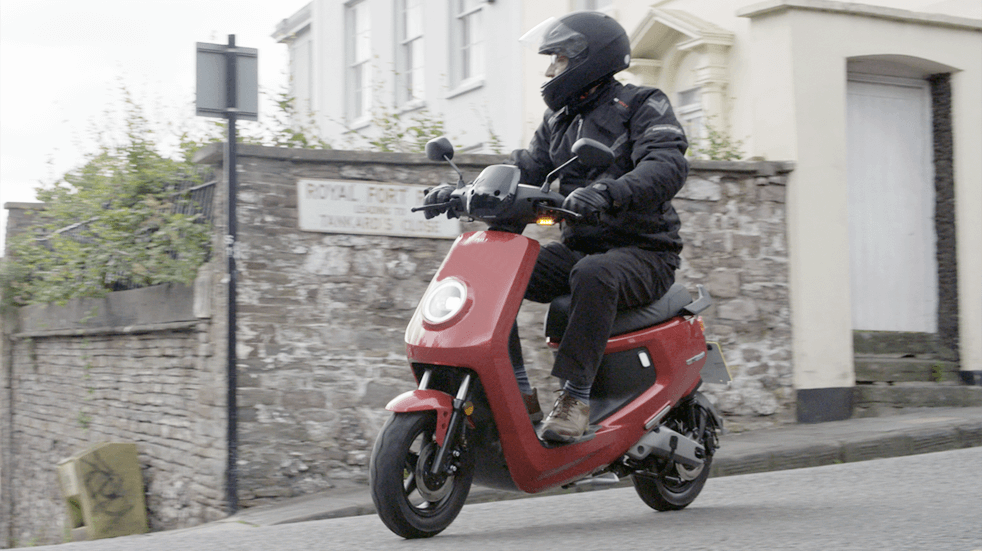
Once on the urban, slower roads the M+ came into its own. It pulls away swiftly and predictably and that coupled with the superb handling makes it great fun. Yes, you feel the patched up potholes but the M+ is light and predictable so you can really enjoy sitting “into” it and getting it cranked over on the bends. The auto-cancelling indicators and cruise control make your journey easier, and it connects to the NIU Cloud so you can see the data from your rides on your phone (and even run maintenance checks). It has two power modes (the lower-power setting will conserve the battery charge). And when it’s plugged in to charge up with the battery still in the bike, you can see on the dash how long it’ll take.
It’s a nimble little scooter and for the short journeys I take commuting to work, it would be in its element. This scooter is the epitome of ecologically sound personal transport for commuting.
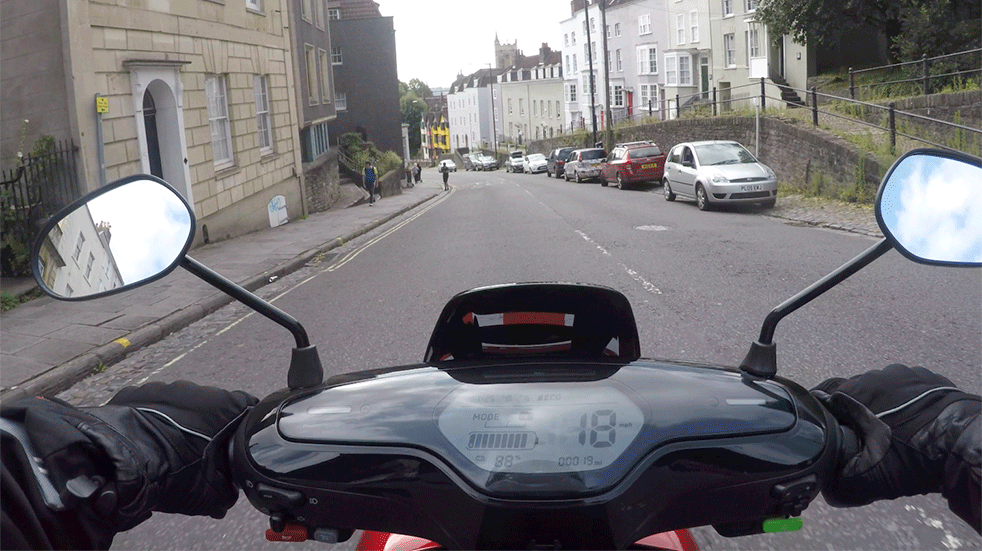
NIU NGT
The NIU NGT is the more powerful of the two, and as we set off on our ride I knew this scooter would be a class act and hard to beat. The handling is reassuring, probably helped by the low centre of gravity – one of the two batteries is in the floor of the scooter under your feet. New riders will feel very confident on the NIU NGT. It’s extremely comfortable and the riding position was perfect for me. The controls fell easily to hand with the indicator switch well placed and with GPS self-cancelling (very clever). On the right is the power mode switch with three levels: Sport, Dynamic and E-Save. I set off in the default “Dynamic”.
Pulling away on the NGT is a great experience. The quiet, the smoothness and the immediate acceleration all give a grin-factor of 10 out of 10. And, oh yes, it’s a smug grin too as you silently glide by the stationary diesel SUVs queuing at the lights. The bus lanes are open for bikes in Bristol so this makes for a very speedy and safe commute into the city centre.
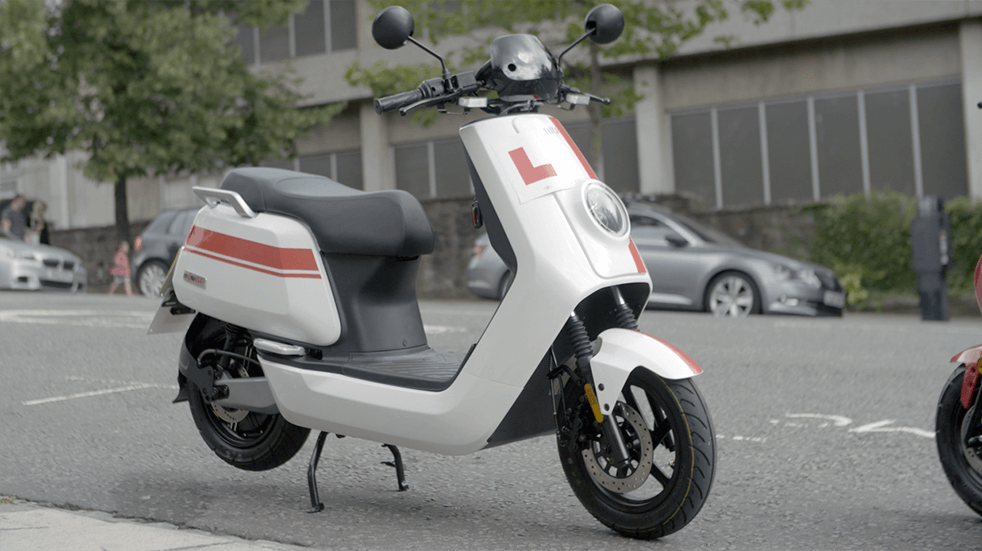
On a faster stretch of road I switched from Dynamic to Sports mode and was surprised by the real boost in performance, with the top speed around 45mph thanks to the hub-mounted 3000w Bosch motor. The NGT has the brakes to match the speed too. A fully integrated EBS Energy Recovery System ensures you pull up evenly and all the while charging the batteries.
It has two separate batteries, which can be charged in-situ on the bike with a splitter, or removed for charging indoors – and they’re light enough to be removed with ease. If you want a lighter bike without the fastest mode you can ride with just one of the two batteries. You’ll need seven hours to get a full charge but there is a 3.5 hour flash charge to get you 60 miles in E-Save mode. GPS sat nav is included on the colour dashboard, as well as the NIU Cloud features (see the M+ review above). The NGT is quite a formidable package.
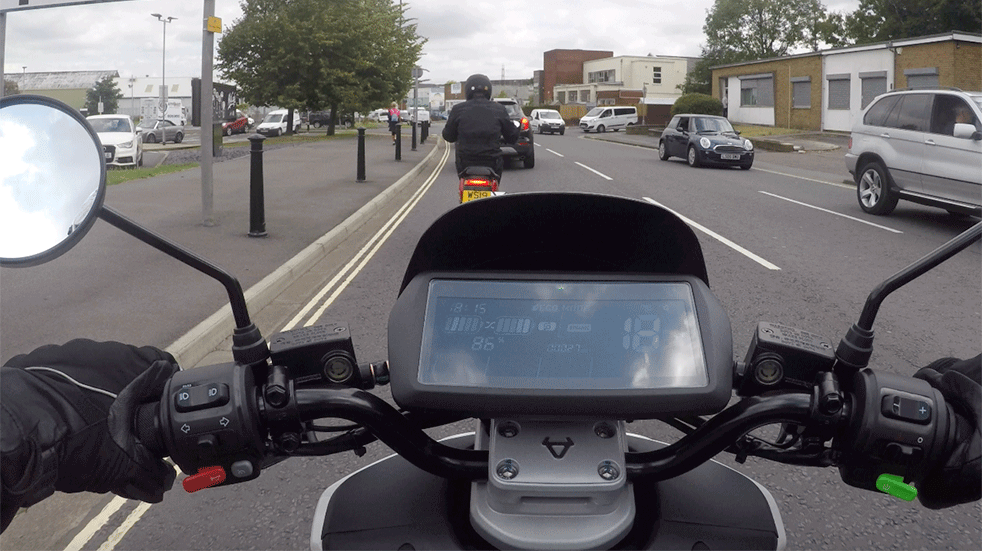
Super Soco TC
First impressions of the Super Soco range is good. They are smart looking bikes without the overtly aggressive styling of some of the Japanese and Italian petrol equivalents. The TC is available with the power profile set to 28mph, or a slightly quicker maximum top speed of 45mph. The bike we tested was happy up to 40mph top speed in high power mode. Through the city centre it was more than capable of keeping pace but on the open road was happier around 35mph.
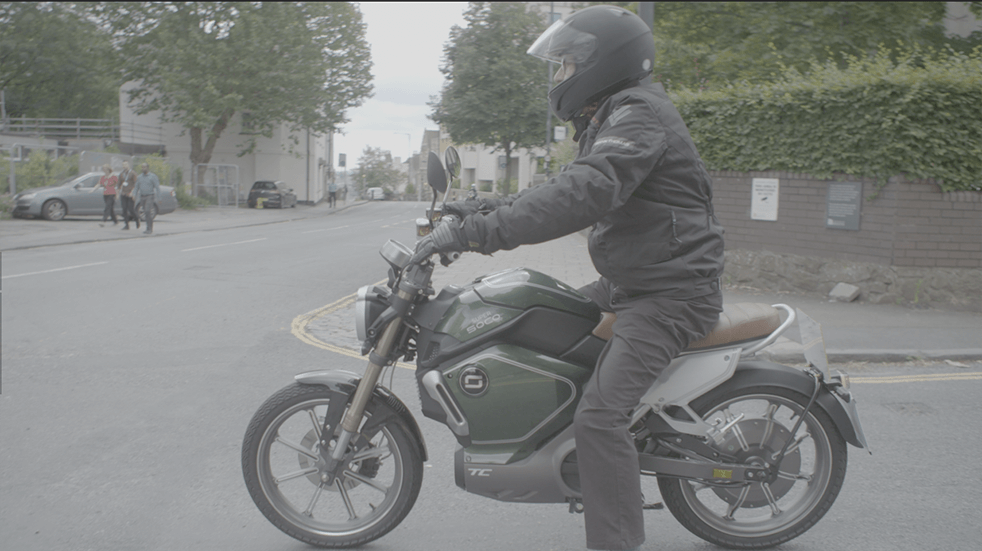
Meirion tells us that with some programming changes the power distribution can be tweaked for varying performance characteristics. Our bike had a single battery but there is space for dual batteries, which would give increased range.
Nevertheless it’s a fun bike to ride and, although the Bosch motor is hub mounted, it has similar handling characteristics to the TC Max (reviewed below). Overall I must admit I preferred the ride on the TC and felt more inclined to push it through the bends. It’s a lovely little bike and felt more relaxed than the TC Max. Another great bike for town and city commuting and it really does look smart.
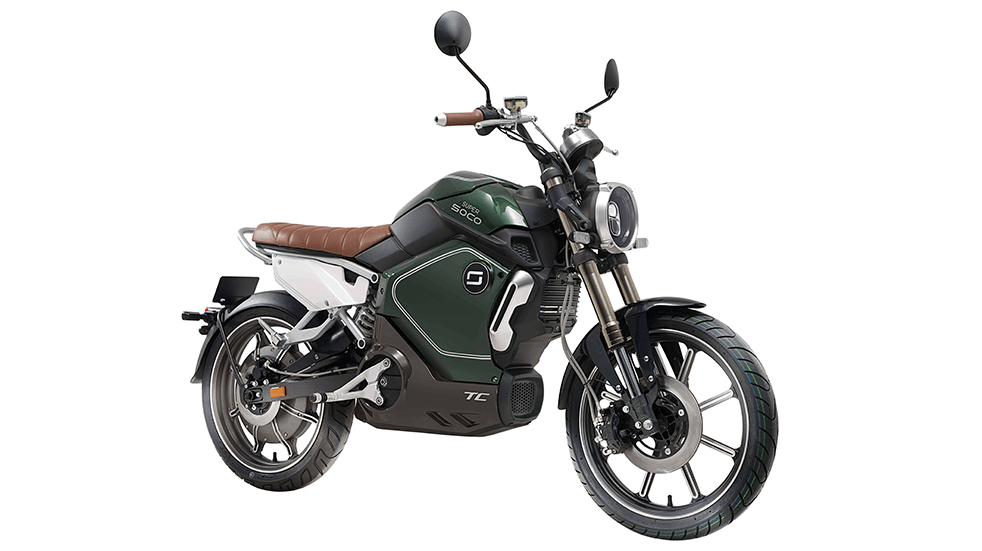
Super Soco TC Max
The TC has a slightly 70’s retro look especially in green with a tan seat. The TC Max has pretty much the same shaped panels and “tank” battery case but in matt black and charcoal greys took on an entirely more contemporary, sharp attitude.
The Max is certainly more powerful and noticeably so. This bike is in a different league to the scooters, for sure, and compared favourably to the Honda CB125f I’ve ridden recently. For urban/extra-urban riding the TC Max has all you need in a learner-legal bike.
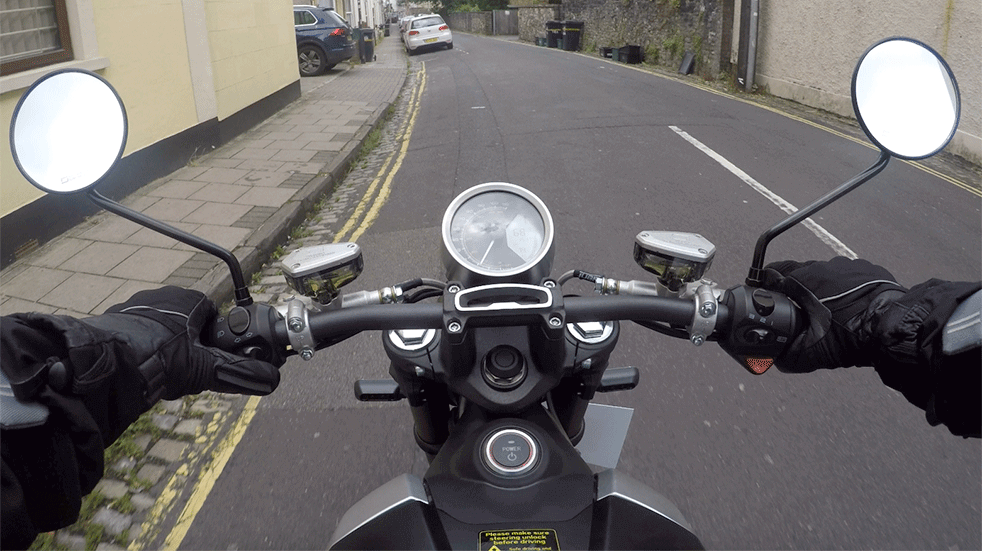
The brakes are smooth and progressive with integrated discs and well capable of bringing you to a dignified halt under pressure. The controls are well placed but I’d become used to the NIU GPS self-cancelling indicators.
Top speed on the TC Max is near 60mph and it doesn’t hang about getting there, as I found out when I switched to maximum power. I had been perfectly comfortable on the second setting, which bodes well for mileage between charges. The manufacturer’s stated maximum range is 60 miles, but this will drop under continuous maximum power and customer feedback would suggest 50 miles (35 miles under hard riding) is more realistic. A charge takes about six-eight hours.
And this brings me to the first of two minor criticisms of the TC Max. The battery is a bit of a beast. With its position in the dummy “tank” it can be a little unwieldy to take out. It’s not prohibitive but I’m sure most riders will prefer to charge in-situ than wrestle with the heavy battery.
The second slight niggle is the power delivery when you try to hold a steady speed around 40-45mph. It is a little tentative and jerky. This is likely to be coming from the power-controller not the motor. The bikes are under continuous development and a firmware modification is likely to improve this. It wouldn’t be something I’d be overly concerned about if I wanted a more powerful e-bike and I’m sure that with greater mileage and experience I’d be able to iron out the glitch.
The TC Max behaves quite well on corners but I didn’t get the urge to push it hard, as I had with the scooters. Maybe it’s the riding position but I certainly wanted to grip the “tank” with my knees to feel at one with the bike. But for the money it’s a fantastic learner bike with great environmental credentials.
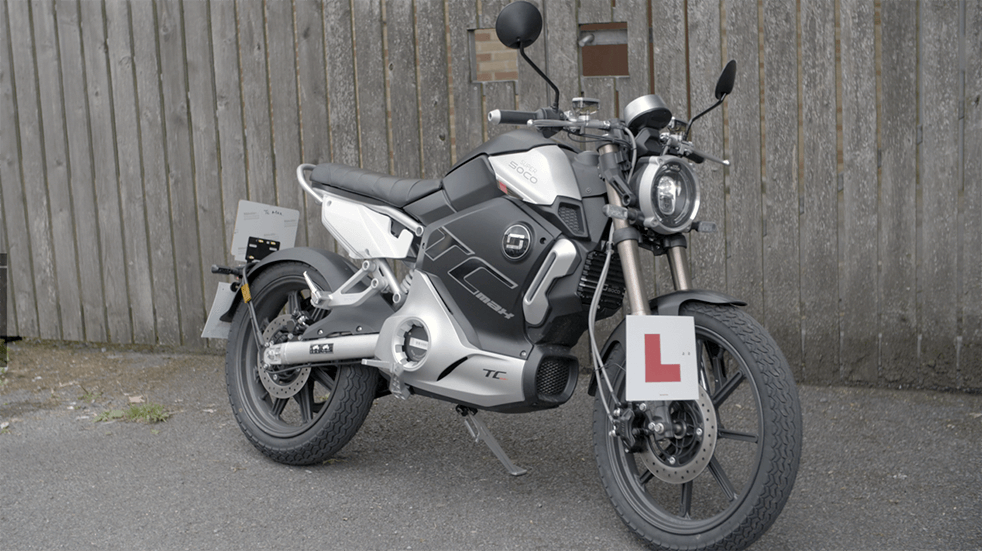
Summary
Returning at the end of our test I was sorry to have to give the bikes back. It had been a thoroughly enjoyable day and I’d have liked to just keep on riding! But this was only a first impressions test so there was much we had to leave unexplored. All these machines have something special about them but the star of the show was, unexpectedly to me, the NIU NGT. I loved that scooter, it is comfortable; more than quick enough for commuting; it looks great; handles like a dream and at 1p/mile running costs who can argue with that. So if a Zero e-motorbike at £7k or a Harley Davidson “Livewire”TM at a cool £29k is out of your budget, NIU and Super Soco can get you charged up.
With thanks to Meirion Guyon, Manager Avon Motorcycles.
Our test-ride route
Five miles, Avon Motorcycles, Emery Road, Brislington to Bristol centre and St Michael’s Hill via St Philip’s and Easton.
Overview of machines tested
|
Model |
Motor |
Range (Miles) |
Top Speed (MPH) |
|---|---|---|---|
|
NIU M+ |
1400w hub Bosch |
47-62 |
28 |
|
NIU NGT |
3000w hub Bosch |
49-108 |
43 |
|
Super Soco TC |
1500w hub Bosch |
25-40 |
28mph (or 45mph) |
|
Super Soco TC Max |
3500w centrally mounted |
35-60 |
58 |
Prices range from £1971 for the NIU M+ to £3999 for the Super Soco TC Max
Inclusive of OLEV Plug-in Motorcycle Grant – see dealers for more information.





